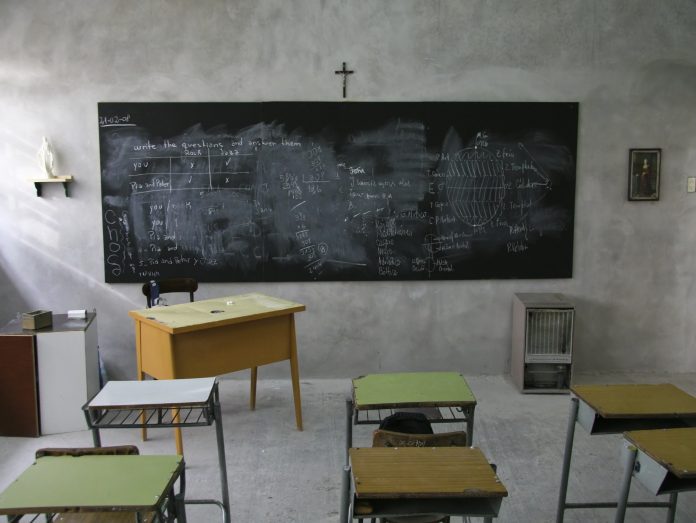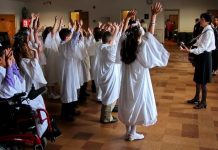
by Kathy and Mitch Finley
When you think about your own family, chances are one of the first words to come to mind isn’t church. Still, we know that our families, as the first and most basic communities of faith, are key to our growth in faith.
To introduce the concept of the domestic church, we often ask groups: What has been the most important influence on your faith? (If the participants are adults, it’s often interesting to ask them to answer this question focusing on their childhood, and then on their adolescence, and then on their adult experiences.)
Although this is a “what” question, the answer that comes from most people’s experience—almost invariably—is a “who” answer. Faith, as we know as catechists, is a person-to-person reality. Almost all of those “who” answers are family members, perhaps a parent or a grandparent; occasionally answers may include a teacher or a pastor.
Our faith, or at least the roots of our faith, is a homemade “product.” But what does that mean? And what are some of the implications for us as catechists in our time with our students?
Respect What God Has Begun
Perhaps the first thing we need to remind ourselves of is that God has already been at work in our students’ lives—and in ours—before we ever set foot in a classroom. What we have is the privilege of building on what God has already begun in our students’ lives.
In his book Pass It On, James Ewens, SJ, suggests that the way parents share faith with their children is best compared to the way parents handle sex education or information about Santa Claus and Christmas. He says that, rather than a formal curriculum, faith is introduced like all the nonverbal attitudes toward the body and physical affection and holiday traditions that parents share year after year with their children. These are powerful influences that we as catechists can supplement in the learning environment, but understand that they’ve already begun in the home.
In a sense, the home is the “lab” where we live out what we’ve learned in theory at church and in catechetical settings. So one of the implications for us is to respect what God has already begun in our students’ lives—and in ours—and to ask our students about their experiences when it’s appropriate.
Respect Diversity
Each domestic church is unique. The influences and experiences you had when growing up or have now in your family aren’t necessarily going to be the ones your students have experienced—from prayer at mealtime or bedtime to family time together to relationships with parents. We need to take that diversity into account in the examples and references we use in the presentation of our lessons.
For example, not all experiences of the domestic church have been positive, as a child reminded Kathy when she was a graduate student in religious education in a New York inner-city classroom. The lesson for the day for the First Communion class was on God as a loving Father. “If God is anything like my old man,” one boy said, “I don’t want anything to do with him.” It was a very honest reaction to a less than healthy experience in that child’s domestic church.
One of the many documents that talks about the domestic church is “Follow the Way of Love,” written to families by the U.S. Catholic Conference of Bishops. It addresses this issue. (A shortened version is available at dnu.org/service/marriagefamily-followwayoflove.pdf) After discussing ways in which families carry out the mission of the Church in their daily lives—such as educating, serving, and celebrating—the bishops say: “No domestic church does this perfectly. But neither does any parish or diocesan church. All members of the Church struggle daily to become more faithful disciples of Christ….There may be families who do not understand or believe they are a domestic church….Perhaps they consider their family too ‘broken’ to be used for the Lord’s purposes. But remember, a family is holy not because it is perfect but because God’s grace is at work in it, helping it to set out anew every day on the way of love.”
When Kathy teaches about the domestic church in her university course on Christian marriage, her students find it helpful to hear that the word holy does not mean “perfect.” In their own way and at their own level, our students need to know this, too, lest they think that their family doesn’t “measure up.”
Respect Your Own Influence
For another implication of the domestic church, an image may be helpful. In terms of your current family or your family of origin, write your name in the center of a piece of paper. Then write the names of other family members around your name, and draw arrows from their names pointing toward yours, representing the influence each of them has had and continues to have on you. If any one of these people would have been different, you likely would have been different as well.
But the picture isn’t complete; add another “pointer” at the other end of each arrow—because, in turn, you have had an important impact on each of the members of your family, an impact you will probably never know—unless you could listen in at your own funeral!
These arrows—this web of relationships—is the way we are made, what we’ve been given by God. Actually, we choose very few of the people in our lives; God chooses them for us. The relationships with them are where the building blocks for our faith come from: love, hope, joy, trust, and forgiveness. Forgiveness, indeed, is important here, because none of us grows up in a perfect family, a perfect domestic church.
You might want to picture each of your students wearing a name tag, but instead of a name, imagine that the tag shows the student’s family picture, his or her domestic church. In a sense, each of us wears such a picture invisibly. (It doesn’t take long, does it, for one of our family members in that web of relationships to come up in conversation, no matter what we’re speaking about?)
Each student brings his or her domestic church into your classroom—as do you. It’s the way God made us. We live in such an individualistic culture that it’s easy to forget how connected we are to one another.
Review and Consider
Let’s review what we know about the domestic church and what we can do as catechists in light of that:
* God is already at work in the domestic churches—the families of your students. You can pray for those families as well as for your students.
* Each domestic church is unique. You may want to visit the families of your students or at least reach out to them with notes or emails.
* We bring our web of relationships with us wherever we go. Give specific homework that will help students make connections between what they are learning in class and what happens in their homes.
****
For Catechists to Consider
1. What qualities did the domestic church of your youth and the web of relationships in your domestic church instill in you? How did those qualities help form and support your faith?
2. Ask your students to pray for specific people in their families every day during the coming week. During the next class, ask them to share about how that went.
3. What unique elements from their own domestic churches can you see in your students, based on their comments or questions?
For Parents to Consider
1. What are the naturally holy places and times in your family?
2. What do you do as a bedtime ritual? Do you do prayers or a blessing?
3. Complete this sentence: I especially experience our family as holy, even though it may not seem explicitly holy, when we…
Kathy and Mitch Finley have been speaking and writing about the domestic church for the past 30 years. Visit their website at mitchandkathyfinley.com.
Copyright 2014, Bayard, Inc. All rights reserved. This article is protected by United States copyright and other intellectual property laws and may not be reproduced, rewritten, distributed, redisseminated, transmitted, displayed, published or broadcast, directly or indirectly, in any medium without the prior written permission of Bayard, Inc.
This article was written by the Catechist Staff and appeared in Catechist magazine, January 2014.
Image Credit: Shutter Stock 36076513




